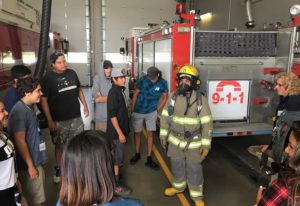First Nations highschool students get a taste of college life

By Colin Graf
SARNIA—A group of First Nations high school students are getting a taste of college life this summer—both the challenges and the fun—thanks to the Lambton College Indigenous Student Centre and Shell Canada Limited.
Lambton’s Indigenous student success coordinator, Sean Hoogterp, says that the three-day camp has two special goals: to introduce students to some of their post-secondary options at community college and to allow the students to get to know other teenagers from nearby First Nations.
Students see a range of shops and labs, from skilled trades such as the millwright program, where they learned about laser calibration and working with metal to the digital photography lab. At the photo lab, students get to make their own light painting, where they draw in the air and “see it picked up as a painting,” according to Hoogterp. They get to save a copy digitally and keep their light art via e-mail.
Hoogterp says that in the kitchens of the culinary arts program, they learn the protocols for working in a kitchen just as college students would, but they do it making their own pizza and baking their own cupcakes for dinner. Other highlights include a trip to the college’s fire school, and even the video game e-sports centre, the hub for Lambton’s video game production and professional gaming programs. “You can make a very decent living” in those fields, Hoogterp adds.
Staying overnight in the college residences, the teenagers also have downtime such as a trip to the movie theatre, and a trip to try the high ropes course put on by the local YMCA. They also get to see some of the programs that prepare them for a career in the oil and petrochemical sector that provides the backbone of the local economy, based in Sarnia’s “Chemical Valley”.
Organizers hope the experience will encourage the 14 campers to pursue further education after high school.
“Like most Indigenous student centres, we encourage education regardless of where they go,” says Hoogterp. “Though, of course, we’d prefer it if they came to Lambton.”

He and other college staff hope the students will get to know each other and form connections, especially with those from other First Nations. Hoogterp says students often feel more comfortable starting at the College if they see a familiar face or two when they first start. Most of the students at the camp are from Aamjiwnaang. The College also is in touch with the Lambton-Kent District School Board to try and include urban Indigenous youth not living on First Nations’ land.
The teens have “had a really wonderful time, it’s great to see them with smiles on their faces,” he says. “You can really see friendships start to form.”
Hooterp says that in selecting students for the camp, organizers meet with parents first.
“In our native communities we are very supportive of each other, and also make sure we know the whole family, not just the student. It’s a relationship between us, the families, and the community,” he emphasizes.
Tariq Saddleback, entering Grade 11 at Kettle & Stony Point, says he learned a lot and had a good time at the camp.
“One thing that kind of stuck with me was the guy at the millwright program who kept making it clear there are a lot of job opportunities in that field,” he says. “You learn a lot, but you also have a lot of fun and meet new people”.
Tanisha Cottrelle, a member of Aamjiwnaang First Nation, says she came to meet other young First Nations people, as she has grown up in a non-Indigenous family.
“I don’t really know a lot about my own background,” she explains. “It’s good to meet new people, and learn there are many opportunities for us at the College, like the millwright and welding. It’s never too early [to think about future jobs].”
Saddleback admits he’s still confused about what he wants for a career.
“A lot of little boys think they want to be a firefighter or police officer, that’s one thing that’s always stuck with me that could come back as a career opportunity,” he shares. “There are so many things I could choose from.”
Jane Manning, manager of Indigenous education at Lambton, says that the grant from Shell has created other opportunities for First Nations youth besides the summer camp.
The money allowed the College to take its mobile trades trailer to Walpole Island to invite young people to find out what a career in welding might by like by trying welding simulators and doing some classroom work, she recounts.
A group of students who completed that work later commuted to Lambton three days a week to take math classes and gain welding experience. Eventually, some of them gained their welding tickets. Some testing is still winding up, Manning says.
The grant also provided 30 new iPads for First Nations’ students and helped craft a workshop to encourage female secondary students to consider the trades as a career choice.
The Centre hopes to continue the camp in future years, though their grant from Shell expires this year.


